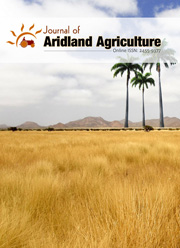Multi-environmental evaluation of wheat tetraploid genotypes for agronomic traits under rainfed conditions in Syria
DOI:
https://doi.org/10.25081/jaa.2020.v6.6275Keywords:
Genotypes, Locations, Rainfed, Tetraploid wheat, Agronomic traitsAbstract
This study was conducted at Homs, Al-Swaida and Tartous, General Commission for Scientific Agricultural Research, Syria during 2016/2017 season. Seven wheat genotypes were planted under rainfed conditions in randomized complete block design with three replications. Studied traits were days to maturity, plant height, number of grain per spike, grain weight per spike, 1000 kernal weight and grain yield per plant to evaluate variance between genotypes and locations. Results showed existence of high variance between studied genotypes in all traits especially plant height. It resulted that genotype W45193 was significantly superior in grain yield per plant with an increasing rate of 69.62% comparing to control Sham 5. Also, it was significantly superior in spike numbers with an increasing rate of 53.53%, 57.24% compared to both controls Sham 3 and Sham 5, respectively. Genotype W45064 was significantly superior in grain weight per spike and 1000 kernal weight compare to both controls Sham 3 and Sham 5. W 45194 was significantly superior in 1000 kernal weight comparing to control Sham 5 (36.34, 31.16 g), respectively. Furthermore, all studied traits (except spike number per plant) were more significant in Tartous compare to both Homs and Al-Swaida.





 .
.